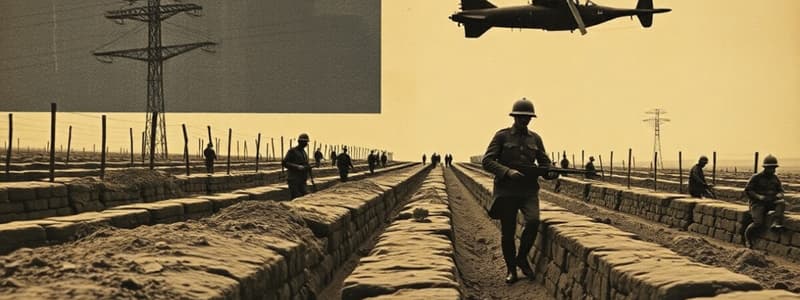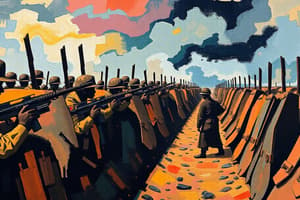Podcast
Questions and Answers
“One out of every four men who went out to the World War did not come back again, and those who came back, many are maimed and blind and some are mad”.
What does this quote indicate about World War I?
“One out of every four men who went out to the World War did not come back again, and those who came back, many are maimed and blind and some are mad”.
What does this quote indicate about World War I?
- There were massive casualties and losses in WWI. (correct)
- The war caused people to adjust their attitudes in life.
- War was a means to achieve great aims.
The Germans' Schlieffen Plan failed because of the following except
The Germans' Schlieffen Plan failed because of the following except
- The German shifted some of their troops to the east, weakening the east bank with France.
- Britain supported France in Marne River battle against Germany.
- The Turks were supporting Russia, but they failed them. (correct)
- Russia mobilized faster than what was expected.
A ______ is a long deadly deadlock in which neither side was able to defeat the other side. The ______ were determined to stop the German from proceeding, sending up the battle cry: “They shall not pass”.
A ______ is a long deadly deadlock in which neither side was able to defeat the other side. The ______ were determined to stop the German from proceeding, sending up the battle cry: “They shall not pass”.
stalemate / French
An allied offensive on ____ was where about 60, 000 British soldiers were killed or wounded.
An allied offensive on ____ was where about 60, 000 British soldiers were killed or wounded.
WWI was considered a new kind of war because of
WWI was considered a new kind of war because of
The use of the new rapid fire machine guns, the debris from artillery shells had a massive destructive effect.
The use of the new rapid fire machine guns, the debris from artillery shells had a massive destructive effect.
Another new weapon that was used in WWI was ___ that caused blindness, chocking, and agonizing burns and blisters.
Another new weapon that was used in WWI was ___ that caused blindness, chocking, and agonizing burns and blisters.
“I suppose I resembled a kind of fish with my mouth open for air. It seemed as if my lungs were gradually shutting up and my heart pounded away in my ears like the beat of a drum .....To get air into my lungs was real agony.”
A soldier’s words, William Pressed, state that
“I suppose I resembled a kind of fish with my mouth open for air. It seemed as if my lungs were gradually shutting up and my heart pounded away in my ears like the beat of a drum .....To get air into my lungs was real agony.”
A soldier’s words, William Pressed, state that
_________were those narrow excavations in the ground. Soldiers used to sleep, eat, and suffer unhuman improper life conditions.
_________were those narrow excavations in the ground. Soldiers used to sleep, eat, and suffer unhuman improper life conditions.
__________ the line, while ____________ served as routes for mail, food, supplies, reinforcements, and the support of wounded soldiers.
__________ the line, while ____________ served as routes for mail, food, supplies, reinforcements, and the support of wounded soldiers.
In WWI, advances in technology, like the use of gasoline-powered engine, led to the use of _____________(though developed to roll on sturdy tracks, they failed to break the stalemate), ____________ that were initially utilized to observe troop movements, and ____________ to attack enemy ships.
In WWI, advances in technology, like the use of gasoline-powered engine, led to the use of _____________(though developed to roll on sturdy tracks, they failed to break the stalemate), ____________ that were initially utilized to observe troop movements, and ____________ to attack enemy ships.
The German used ____ or large gas-filled balloons, to bomb the English coast.
The German used ____ or large gas-filled balloons, to bomb the English coast.
Sky confrontations were made by pilots who were known as _______ .
Sky confrontations were made by pilots who were known as _______ .
_______, which, though being spectacular, had little effect on the course of the war.
_______, which, though being spectacular, had little effect on the course of the war.
Submarines had a nick name by the German: _________, which is driven from the German word “Unterseeboot”. The use of submarines in war allowed Germany to cause tremendous damage to the Allied side, sinking merchant ships carrying vital supplies to Britain.
Submarines had a nick name by the German: _________, which is driven from the German word “Unterseeboot”. The use of submarines in war allowed Germany to cause tremendous damage to the Allied side, sinking merchant ships carrying vital supplies to Britain.
To defend against submarines, the Allies organized _______ or groups of merchant ships protected by warships.
To defend against submarines, the Allies organized _______ or groups of merchant ships protected by warships.
Russia suffered a great defeat in ________ by the German because ________. Still the Russian commanders were insisting on sending masses of soldiers into combat.
Russia suffered a great defeat in ________ by the German because ________. Still the Russian commanders were insisting on sending masses of soldiers into combat.
In 1915, ________ joined the Central Powers, and helped defeat its old Balkan rival ________ while ________ with the hope of gaining some land in Hungary, joined the Allies group.
In 1915, ________ joined the Central Powers, and helped defeat its old Balkan rival ________ while ________ with the hope of gaining some land in Hungary, joined the Allies group.
Also in 1915, Italy, tempted by a secret agreement to be given some Austrian ruled lands inhabited by the Italians, declared war on ________ and later on ________.
Also in 1915, Italy, tempted by a secret agreement to be given some Austrian ruled lands inhabited by the Italians, declared war on ________ and later on ________.
In 1917, the Austrian and the German troops launched a massive offensive against the Italian position in ______ on the Isonzo River.
In 1917, the Austrian and the German troops launched a massive offensive against the Italian position in ______ on the Isonzo River.
Japan, allied with Britain, used the war to seize German outposts in_______.
Japan, allied with Britain, used the war to seize German outposts in_______.
The Ottoman Empire represented a desirable ally for the Allies group because ________.
The Ottoman Empire represented a desirable ally for the Allies group because ________.
The Ottoman Empire joined the ________ and it cut off the crucial allied supply lines to ________ through the Dardanelle, a vital strait connecting ________ to the Mediterranean.
The Ottoman Empire joined the ________ and it cut off the crucial allied supply lines to ________ through the Dardanelle, a vital strait connecting ________ to the Mediterranean.
The battle of ________ was to help open the Dardanelle for the Allies' supplies, but the battle ended up with the Allies withdrawing from the strait.
The battle of ________ was to help open the Dardanelle for the Allies' supplies, but the battle ended up with the Allies withdrawing from the strait.
The Turkish Armenians helped the _______ against the Turks; as a reaction, the Turks departed the entire Armenian population south to _______ and _______ . Some Armenians, then, fled to other countries and settled there.
The Turkish Armenians helped the _______ against the Turks; as a reaction, the Turks departed the entire Armenian population south to _______ and _______ . Some Armenians, then, fled to other countries and settled there.
In 1916, ______ declared a revolt against the ottoman rule. The British government sent a colonel _______, known later as Lawrence of Arabia to support the Arab revolt.
In 1916, ______ declared a revolt against the ottoman rule. The British government sent a colonel _______, known later as Lawrence of Arabia to support the Arab revolt.
People of the European colonies all over the world had mixed feelings serving, while some were reluctant to serve rulers, others were welling to volunteer eagerly since they thought their service will be a step towards _______.
People of the European colonies all over the world had mixed feelings serving, while some were reluctant to serve rulers, others were welling to volunteer eagerly since they thought their service will be a step towards _______.
Flashcards
Casualties of WWI
Casualties of WWI
World War I (WWI) was a devastating conflict that resulted in a significant number of casualties. One-fourth of the soldiers who went to war did not return, and those who did often suffered from injuries, blindness, or mental trauma.
Schlieffen Plan Failure
Schlieffen Plan Failure
The Schlieffen Plan was Germany's strategic plan for winning a quick victory in World War I. However, it failed because Russia mobilized faster than expected, forcing Germany to divert troops from the Western Front.
WWI Stalemate
WWI Stalemate
A stalemate in war is a situation where neither side can gain a decisive victory over the other. The fighting becomes a deadlock, with significant losses on both sides. In WWI, the French were determined to stop the German advance, shouting "They shall not pass!"
Battle of The Somme
Battle of The Somme
Signup and view all the flashcards
WWI: New Kind of War
WWI: New Kind of War
Signup and view all the flashcards
Shrapnel in WWI
Shrapnel in WWI
Signup and view all the flashcards
Poison Gas in WWI
Poison Gas in WWI
Signup and view all the flashcards
WWI Trenches
WWI Trenches
Signup and view all the flashcards
Communication Trenches
Communication Trenches
Signup and view all the flashcards
WWI Technology: Tanks, Airplanes, Submarines
WWI Technology: Tanks, Airplanes, Submarines
Signup and view all the flashcards
Zeppelins in WWI
Zeppelins in WWI
Signup and view all the flashcards
Flying aces in WWI
Flying aces in WWI
Signup and view all the flashcards
Dogfights in WWI
Dogfights in WWI
Signup and view all the flashcards
U-boats in WWI
U-boats in WWI
Signup and view all the flashcards
Convoys in WWI
Convoys in WWI
Signup and view all the flashcards
Battle of Tannenberg
Battle of Tannenberg
Signup and view all the flashcards
New Entrants to WWI: Bulgaria and Romania
New Entrants to WWI: Bulgaria and Romania
Signup and view all the flashcards
Italy Joins WWI
Italy Joins WWI
Signup and view all the flashcards
Battle of Caporetto
Battle of Caporetto
Signup and view all the flashcards
Japanese Expansion in WWI
Japanese Expansion in WWI
Signup and view all the flashcards
Ottoman Empire's Strategic Importance in WWI
Ottoman Empire's Strategic Importance in WWI
Signup and view all the flashcards
Battle of Gallipoli
Battle of Gallipoli
Signup and view all the flashcards
Armenian Genocide
Armenian Genocide
Signup and view all the flashcards
Arab Revolt
Arab Revolt
Signup and view all the flashcards
Colonial Peoples in WWI
Colonial Peoples in WWI
Signup and view all the flashcards
Study Notes
Chapter 14 Section 2 - A New Kind of War
- World War I Casualties: One out of every four men who fought in World War I did not return, many were injured or mentally affected.
- Schlieffen Plan Failure: The German Schlieffen Plan failed due to unexpected Russian mobilization, Turkish support failure, and German troop deployments weakening the eastern front.
- Stalemate: A prolonged deadlock where neither side could defeat the other, characterized by trench warfare and determination to halt enemy advances.
- Somme River Offensive: An allied offensive at the Somme River resulted in significant casualties for the British.
- New Kind of War: World War I was considered a new type of war due to technological advancements like rapid-fire machine guns, artillery shells, new weapons, and extensive use of technology in warfare.
- Rapid Fire Machine Guns: These weapons caused significant destruction and casualties in combat.
- Artillery Shells: Detrimental effects of shrapnel from artillery shells, causing massive destruction.
- Poison Gas: This weapon introduced blindness, choking, and agonizing burns and blisters in World War I; another new weapon was poison gas
- Trench Warfare: Narrow excavations in the ground became crucial fortifications, characterized by unsanitary living conditions and limited mobility for soldiers.
- Communication Trenches: Trenches dug in zig-zag patterns to deter enemy fire; connecting trenches for supply routes.
- Modern Warfare Technology: Gasoline-powered engines advanced warfare extensively, impacting land and sea operations.
- Gas Filled Balloons: The Germans used large gas-filled balloons to attack the English coast.
- Flying Aces: Pilots engaged in aerial combat, though this had a limited impact on the war.
- Submarines: German submarines caused significant damage to Allied supply ships.
- Allied Convoy System: The Allies organized convoys to protect merchant ships from attacks by submarines.
- Ottoman Empire Ally: The Ottoman Empire allied with the Central Powers, a move that cut off allied supply routes through the Dardanelles strait.
- Italian Position: A major offensive against the Italian army by the Austro-German forces in the Isonzo River region.
- Japan's Seizure: Japan sought to seize German overseas territories, highlighting the global nature of the war.
- Arab Revolt: The British supported Arab revolt against the Ottoman Empire
- Armenian Population: The deportation of the Armenian population south by the Ottoman Turks.
- Military Leaders: Different military leaders and their roles in the war and support efforts.
- World War I Participating Countries: Details of countries participating in WWI at various stages.
- Allies and Central Powers: Details about the opposing sides in the war.
- Technology Influence: Focus on the influence of new technologies on warfare.
Studying That Suits You
Use AI to generate personalized quizzes and flashcards to suit your learning preferences.




